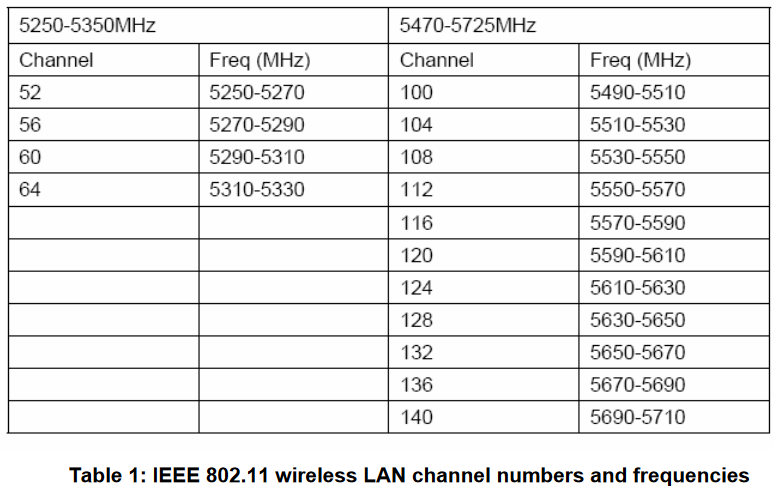关于雷达(Radar)信道
有些时候,我们在实际的无线网络中,会遇到无线信道一致flapping的情况,即便我们自定义了信道的,发现也会出现flapping。如果这种情况,可能需要确认是否你使用的信道上检测到了雷达。
这里记录一些关键的信息:
1、关于固定频率与跳频
固定频率一般是使用在天气雷达,5600至5650 MHz频段已分配给天气雷达。
一些军用雷达使用跳频技术。
2、IEEE 信道分配

关于更多的信息,可以参考Spectrum Sharing in the 5 GHz Band DFS Best Practices:
http://www.ieee802.org/18/Meeting_documents/2007_Nov/WFA-DFS-Best%20Practices.pdf
在思科的AP上,有说明动态频率选择(DFS)信道中的雷达检测。
A 介绍
本文档简要介绍了动态频率选择(DFS)信道中雷达检测的工作原理,以及如何减轻其对无线网络的影响。
B 背景资料
在大多数监管领域,当使用5GHz频段中的部分或全部信道时,802.11客户端需要使用动态频率选择(DFS)。在DFS信道中传输之前,802.11客户端必须验证(通过首先监听60秒)其上没有雷达活动。而且如果802.11 radio在使用DFS信道时检测到雷达,它必须快速腾出该信道,避开雷达使用的信道,因此,切换到另一个DFS信道,这将(至少)有一分钟的中断。
当AP使用DFS信道并检测到雷达信号时,AP的行为如下:
- 停止在该通道上传输数据帧
- 广播802.11h频道切换公告。
- 解除客户关系
- 从DCA(动态通道分配)列表中选择不同的通道
- 如果所选通道不是DFS,则AP启用信标并接受客户端关联
- 如果AP选择DFS所需的信道,它将在新信道上扫描雷达信号60秒。如果新信道上没有雷达信号,则AP启用信标并接受客户端关联。如果检测到雷达信号,则AP选择不同的信道
DFS触发的信道更改会影响客户端连接。当我们检查AP日志时,我们可以看到类似于以下内容的消息:
For COS APs
[*04/27/2017 17:45:59.1747] Radar detected: cf=5496 bw=4 evt='DFS Radar Detection Chan = 100' [*04/27/2017 17:45:59.1749] wcp/dfs :: RadarDetection: radar detected [*04/27/2017 17:45:59.1749] wcp/dfs :: RadarDetection: sending packet out to capwapd, slotId=1, msgLen=386, chanCnt=1 -100
For IOS APs
Feb 10 17:15:55: %DOT11-6-DFS_TRIGGERED: DFS: triggered on frequency 5320 MHz
Feb 10 17:15:55: %DOT11-6-FREQ_USED: Interface Dot11Radio1, frequency 5520 selected
Feb 10 17:15:55: %DOT11-5-EXPECTED_RADIO_RESET: Restarting Radio interface Dot11Radio1 due to channel change from 64 to 104
C 与DFS频道共存
“假DFS事件”是指radio错误地检测到雷达。它检测到了它认为是雷达的能量模式,而实际那不是真正的雷达信号(它可能是来自附近客户无线电的信号)。很难确定雷达探测事件是否“错误”。如果在同一位置的同一DFS信道上有多个AP无线电,那么我们可以假设,当单个AP在给定时间检测到雷达,那么它可能是错误检测,而如果是多个无线电同时检测雷达,它很可能是“真正的”雷达。
思科对我们的接入点区分真实和虚假雷达信号的能力进行了大量改进;然而,不可能完全消除所有虚假的雷达探测。通常,如果使用具有密集客户端群的DFS信道,则应准备每个AP无线电处理多达四个错误DFS事件,当然还有真实雷达事件。
为了减轻/减少这些事件的影响,我们可以:
- Use 20MHz channel width, which also allows better reuse of non-DFS channels
- Avoid DFS channels
- For the FCC domain: there are 9 non-DFS channels (36-48,149-165). Except for very dense deployments, these are enough channels (if using 20MHz wide) to provide full coverage with tolerable co-channel interference at full (14-17dBm) power
- For the ETSI domain: there are only four non-DFS channels (36-48 UNII-1)
- Consider channel assignments such that there is at least one UNII-1 channel available throughout the coverage area
- Then use DFS channels, to provide additional capacity.
- In order to reduce the impact of DFS events
- Enable 802.11h Channel Announcement - enabled by default on WLC
- Disable Smart DFS - enabled by default on WLC
- Use CleanAir APs with superior radar detection capabilities
- The 1700, 2700, 3700,1570, 2800, 3800, 4800, and 1560 series APs can
use CleanAir hardware to support additional DFS signal filtering to
avoid false events.
- For 1700, 2700, 3700, 1570, 2800, 3800: this is available in 8.2.170.0, 8.3.140.0, 8.5.110.0 and 8.6. (CSCve35938
 , CSCvf38154
, CSCvf38154  , CSCvg43083
, CSCvg43083  )
) - For 1560: this will be available in the 8.5MR4 and 8.8MR1 releases (CSCve31869
 )
)
- For 1700, 2700, 3700, 1570, 2800, 3800: this is available in 8.2.170.0, 8.3.140.0, 8.5.110.0 and 8.6. (CSCve35938
- The 1700, 2700, 3700,1570, 2800, 3800, 4800, and 1560 series APs can
use CleanAir hardware to support additional DFS signal filtering to
avoid false events.
- If DFS channels are needed on non-CleanAir APs
- A 20MHz space between channels benefits non-CleanAir APs (such as 18XX, 1540 ). Example: use 52, (skip 56), use 60, (skip 64), use 100, (skip 104), use 108, ...
- 1800 series APs have improved radar detection in 8.3.140.0, 8.5.120.0 and 8.6 (CSCvg62039
 , CSCvf21657
, CSCvf21657  .)
.)
原文参考:
https://www.cisco.com/c/en/us/support/docs/wireless-mobility/80211/213882-radar-detection-in-dynamic-frequency-sel.html
https://www.cisco.com/en/US/docs/routers/access/wireless/software/guide/RadioChannelDFS.pdf
https://www.cisco.com/c/en/us/support/docs/wireless-mobility/wireless-lan-wlan/91565-radar-survey-wmn.html

